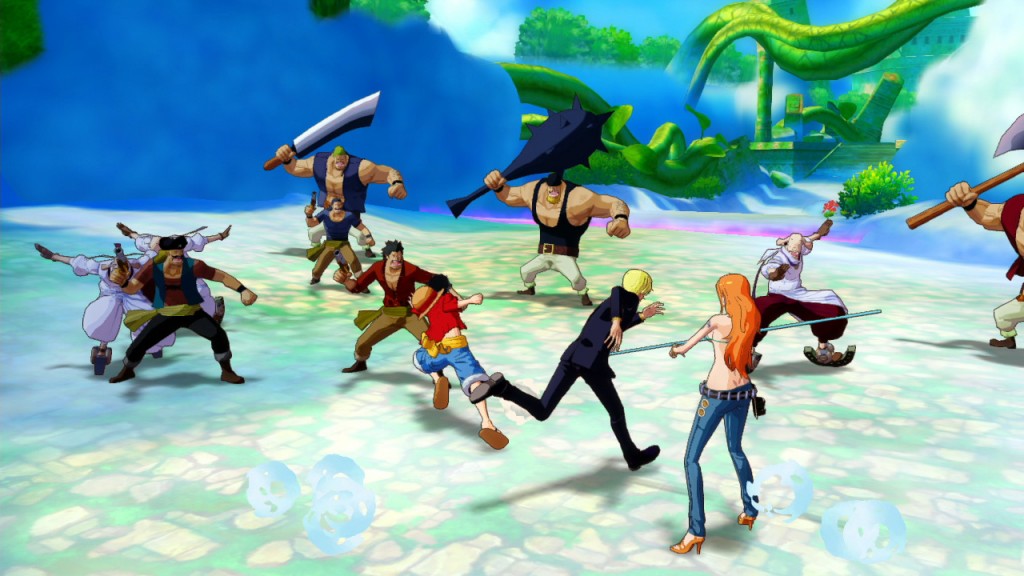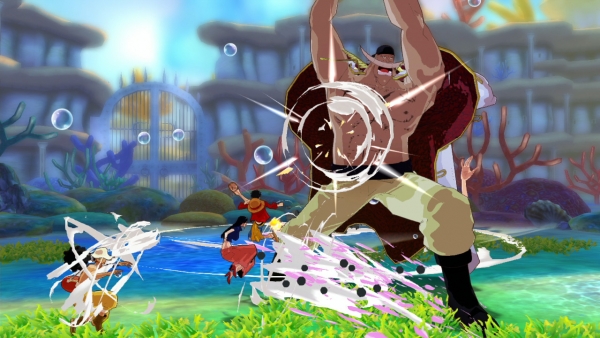
One Piece is dumb. Some will no doubt consider that an insult, but I mean it in the best possible way. It’s crazy, and silly, and over the top, and it doesn’t take itself seriously at all. If you were trying to show someone just how crazy manga and anime can get, One Piece is the series you’d choose, hands down. That focus on big, dumb, self-referential fun, coupled with hilarious, distinct characters is probably what has spurred the series to become the best-selling manga series of all time, and one of the longest running animes, as well.
Of course, this rampant success has carried over into video games, and Unlimited World Red is the latest game that has spun out of the franchise. The story drops you into the boots of Luffy and the Straw Hat Pirates, as they are transporting new friend Pato, a talking raccoon, home to “The Island of Promises” and Transtown, a small, seaside port. The crew lands to drop Pato off and gather supplies, and finds themselves enjoying the hospitality of the local inn after Luffy rescues the innkeeper from some local ruffians. When Luffy wakes up after enjoying a hearty meal, he finds the rest of the crew is missing, and sets off to rescue them.
What follows is a self-contained romp across multiple locations. This is great, especially for those of us who have never really experienced One Piece before now. I’ll admit it: before this, all I knew about Luffy was that he was a pirate with stretchy arms and played a mean game of Street Fighter IV on his days off, but I was pretty interested in the game world when all was said and done. Naturally, the story also contains a number of references and in-jokes, and finds an interesting way to bring back many vanquished friends and foes, which will no doubt please longtime fans.
"A lot of effort has clearly been put into capturing the anime’s colorful art style and mannerisms of the major characters, and this adds quite a bit to the experience."
The characters, in all of their silly, hilarious, absurd glory are the real stars, however, whether it’s Luffy’s never say die attitude, Franky’s tendency to get excited over the smallest things, or Sanji’s obsession with Robin. A lot of effort has clearly been put into capturing the anime’s colorful art style and mannerisms of the major characters, and this adds quite a bit to the experience. It’s a good thing, because Unlimited World Red’s gameplay isn’t really anything to write home about.
You’ll move around the game’s fairly large environments, encountering enemies as you go. Often, the game will lock you into a confined space until you’ve beaten the baddies, and then allow you to move on. Combat is fairly simple: you’ve got light and heavy attacks, special moves, and a team attack that takes your entire special bar and will all but wipe out an entire group of enemies. Add the requisite context sensitive block/dodge button, and you’ve got what amounts to Dynasty Warriors-lite. The big difference is that you can switch between your party members on the fly, and that your allies are actually useful, and do not take damage.
These are welcome additions, but they don’t do much to change what is a pretty standard combat system. The game does its best to distract the player by challenging you to complete a series of combos without being hit for more damage, but that doesn’t stop the combat from becoming a repetitive slog during long play sessions, especially when the game forces you to go back to an area you’ve previously cleared and fight enemies until they drop an item you need to unlock the next area. The one exception to this is the boss fights, which are challenging, engaging, and varied. The patterns behind the bosses are pretty simple, but they’ll force you to change up your combat style, and provide a nice change of pace from the more standard villains the game throws at you.
"When you’re not fighting, you’ll be exploring the environment for items, fishing, and catching local critters, all of which can be used in the game’s crafting system. You can spend the materials you find to craft items, but the real reason to chase this stuff is so you can expand Transtown."
Fighting and completing chapters will gain you levels, which will increase your stats and allow you to access new abilities. Unfortunately, the game doesn’t really do much to teach you how these abilities work. You’ll eventually get it through experimentation, but good luck trying to figure out the difference between a Skill Word (skills you can use in the environment to access new areas), an Item Word (buffs you can use in battle), and a Custom Word (passive buffs) before that.
When you’re not fighting, you’ll be exploring the environment for items, fishing, and catching local critters, all of which can be used in the game’s crafting system. You can spend the materials you find to craft items, but the real reason to chase this stuff is so you can expand Transtown. Get enough materials, and you’ll be able to build new buildings, like a tavern, factory, or pharmacy, which will allow you to access to side quests, minigames, and farming, all of which give you access to more crafting materials.
It’s a neat little system that encourages you to interact with Transtown, which serves as the game hub, and the people within it, and gives you something to do when you don’t feel like going through a mission. It’s a lot of fun to fly around town with Luffy’s stretchy abilities, and expanding the hubworld is actually quite rewarding.
"That’s where Battle Coliseum comes in. This mode eschews all of the town building and RPG elements of the Story Mode, and focuses squarely on the action. Battles boil down to small skirmishes, one on one duals, and two on two team fights."
The only problem is that the game will occassionally lock you out of the story missions until you’ve expanded certain sections of the town, which forces you to go back to old areas and play minigames before you can advance the plot. This would be fine if you had some investment in building the town beyond “Get more stuff so you can build the town so you can get more stuff.” As fun as it can be, it’s completely ancillary and has no impact on the main plot whatsoever, and the requirement can be pretty frustrating when all you want to do is go to the next area.
That’s where Battle Coliseum comes in. This mode eschews all of the town building and RPG elements of the Story Mode, and focuses squarely on the action. Battles boil down to small skirmishes, one on one duals, and two on two team fights. There are three tiers to fight through, and each win will earn you points until you rank up, which will grant access to the next tier. Progress far enough and you’ll unlock new characters as well as quests that you can play in Story Mode.
Ultimately, One Piece Unlimited World Red is a game for the fans. It’s all here: the look, the characters, the art style, the fan service. It captures the look and feel of the series it is based on perfectly. Some will no doubt be let down by the lack of English voice acting and the presentation issues that come with being ported from the 3DS, but it’s a solid package overall, if one that feels a little repetitive. It’s let down by some weird design decisions, but those looking to join Luffy and crew on a fun romp through some uncharted waters will find a lot to like here, even if it is a little stretched out.
This game was reviewed on the PlayStation 3.
Fantastic art style captures the series's look. Unique and interesting characters. Engaging boss fights. Lots of side content. Story is accessible to newcomers but provides plenty for old fans. Battle Coliseum is great for those who want more combat.
Combat is extremely limited and repetitive. Having to backtrack to unlock new areas. Having to build parts of the town to unlock new areas. RPG elements are poorly explained. No English voice acting.


















